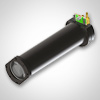- About Us
- Products

Light Engines
Next-generation, high intensity, multi-configurable LED light engines
LED Projectors
Uniform illumination, Pattern projection, Solar simulation
UV Light Engines and Systems
High intensity UV-LED light engines and DMD illuminators
Drivers and Controllers
High power, programmable drivers & controllers
Thermal Management
Thermal pads, heatsinks, cooling fans - Custom Systems
- Industries &
Applications - Our Technology
- In the News
Frequently Asked Questions
What type of power supply should I use to drive your LEDs?
LEDs should only be driven by a current source and never a voltage source. Typical of diodes, a small change in voltage can result in a very large change in current. IOI has a range of LED drivers and controllers that are available designed for the LumiBright LE and LS product lines. Alternatively, any good laboratory grade current controlled power supply can be used provided the current and voltage settings specified in the product literature are observed. As a word of caution, even if a laboratory grade power supply is switched to current mode, the voltage still should not exceed the order of 1 Volt above the rated voltage for the device; otherwise the inductance in the line could damage the LED device.
What LED wavelengths are available?
IOI specifies standard LED die wavelengths in the specific product literature, however, if other wavelengths are required for your application, non-standard wavelengths can be accommodated, provided they are available from our LED die vendor. Please contact a Sales Representative or Applications Engineer with your specific requirements for non-standard wavelengths.
Why do certain LumiBright Light Engines use only specific wavelengths?
Our LumiBright Light Engines come in two materials: optically stable plastics and glass. Through testing, we have determined which lens materials match with specific output wavelengths. All known plastics degrade over time in transmission when subjected to the blue and UV spectrum which cause yellowing. The color degradation is a function of the total integrated energy density and the temperature of the plastic. Certain applications with sufficiently low total integrated energy density may be able to use plastics at shorter wavelengths subject to IOI approval, but in general the whites, UV, and lower ‘blue’ wavelengths must be paired with glass optics (360nm thru 469nm). The remaining wavelengths can use either material. White is limited in use for plastic optics because the blue spectrum used by white LED applications does cause cumulative damage to the optics.
Choosing the correct IOI product/material for your application requires answers to several questions:
• What sort of duty cycle will be expected?
• Will our product be pulsed? Or continuous?
• What are the cumulative hours of use?
• Will our product be running at low current? Or high current?
• What is the total integrated energy in Joules for a given optic?
• What is the operation temperature?
For additional information please contact our sales engineer. (sales@innovationsinoptics.com)
